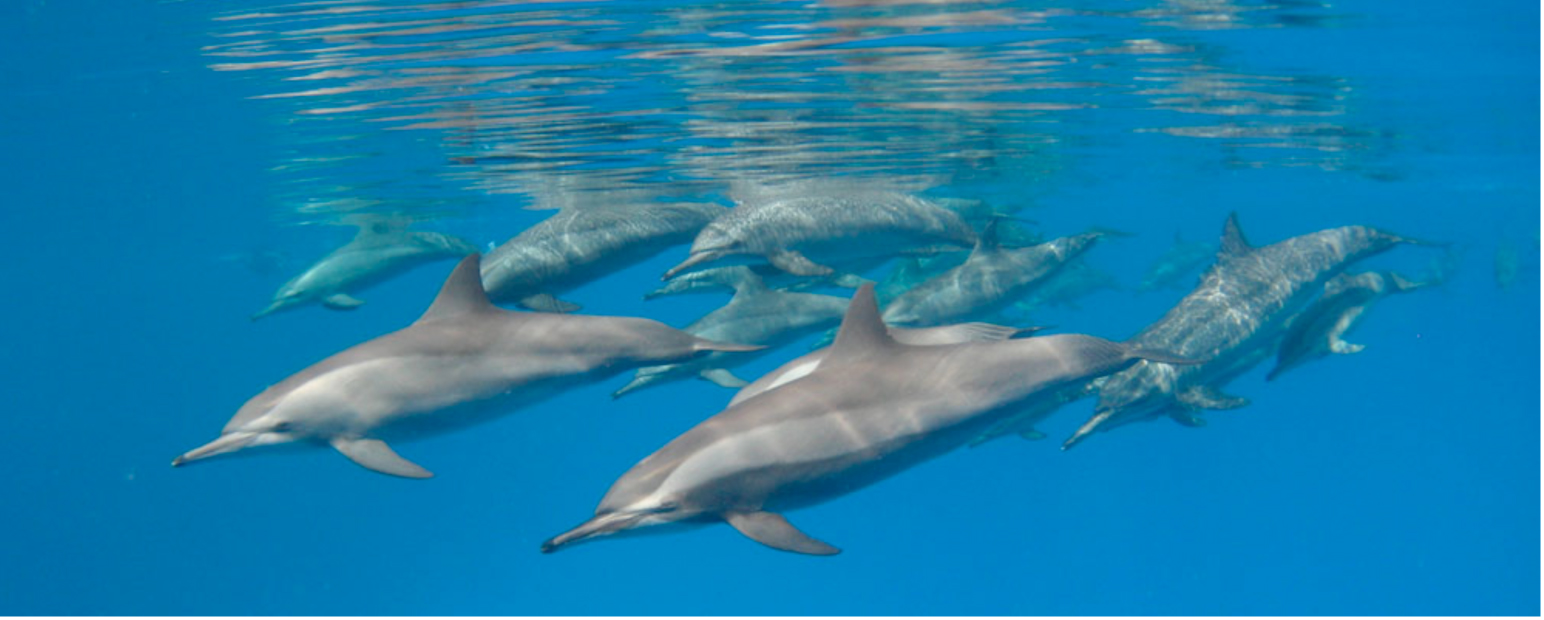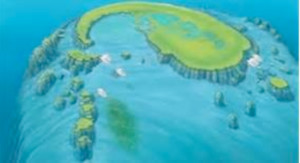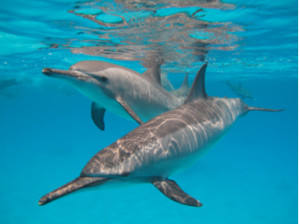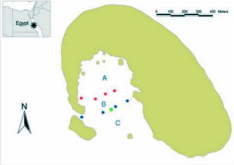Marine Life & Conservation
Samadai – A Dolphin Reserve in the Red Sea

A world without dolphins… it’s hard to imagine, but it is a possibility. Pollution, starvation, and persecution all takes a toll – but there are places in this world where people have said ‘enough is enough’ and have taken steps to reverse this insidious trend.
One such place is Samadai in the Red Sea, which is a haven for Spinner Dolphins. General Mohamed Kamel, Governor of the Red Sea, has issued a new decree handing over management of Samadai to HEPCA (Hurghada Environmental Protection and Conservation Association).
HEPCA: “The Samadai management plan has been one of our community’s most important achievements towards protecting the dolphins of the Red Sea. This initiative was the first time that civil society, the government, and the tourism sector set aside their differences to protect one of our countries most valuable resources. This model will always stand as a testament of our community’s ability to mobilize in protection of our environment and natural resources”.
Shantel Seoane is Media and Communications Officer at HEPCA.
Jeff: Can you describe in physical terms what Samadi is?
 Shantel: There are only a handful of marine habitats in the world comparable to Samadai. There are even fewer natural dolphin sanctuaries in the world and none that are under special protected status. Samadai is a rare and biologically diverse natural wonder and one of the most beautiful off-shore reefs in the region for swimming/snorkelling/diving. Not only is Samadai a habitat for hundreds of spinner dolphins; it is also one of the only places in the world where you can interact with them in their natural habitat. The Samadai initiative is an internationally recognized conservation model and a functioning example of sustainable tourism development. The Samadai initiative generates revenue and employment for the southern Red Sea’s tourism dependent economy. Samadai is a powerful destination highlight to help bolster tourism into Marsa Alam and the model will exemplify this destination’s environmental performance, thereby ensuring competitiveness on the world tourism market.
Shantel: There are only a handful of marine habitats in the world comparable to Samadai. There are even fewer natural dolphin sanctuaries in the world and none that are under special protected status. Samadai is a rare and biologically diverse natural wonder and one of the most beautiful off-shore reefs in the region for swimming/snorkelling/diving. Not only is Samadai a habitat for hundreds of spinner dolphins; it is also one of the only places in the world where you can interact with them in their natural habitat. The Samadai initiative is an internationally recognized conservation model and a functioning example of sustainable tourism development. The Samadai initiative generates revenue and employment for the southern Red Sea’s tourism dependent economy. Samadai is a powerful destination highlight to help bolster tourism into Marsa Alam and the model will exemplify this destination’s environmental performance, thereby ensuring competitiveness on the world tourism market.
Jeff: How many Dolphins are there?
Shantel: Data analysis of photo ID has led to the identification of  218 animals and more are being added to the catalogue after recent surveys. This figure number includes identifiable individuals (marked) photographed at least once in the waters of Samadai since October 2005. Since a large portion of the population is composed by unmarked individuals (i.e. not identifiable because the edge of their dorsal fin is intact) it is not possible to count all the individuals using Samadai. However, methods do exist to account for this and provide a robust estimation of the population size: HEPCA team made use of one of the most widespread method (based on mark-recapture technique) and estimated that at least 480 animals do visit Samadai.
218 animals and more are being added to the catalogue after recent surveys. This figure number includes identifiable individuals (marked) photographed at least once in the waters of Samadai since October 2005. Since a large portion of the population is composed by unmarked individuals (i.e. not identifiable because the edge of their dorsal fin is intact) it is not possible to count all the individuals using Samadai. However, methods do exist to account for this and provide a robust estimation of the population size: HEPCA team made use of one of the most widespread method (based on mark-recapture technique) and estimated that at least 480 animals do visit Samadai.
Jeff: Why was it necessary to form a sanctuary in the first place?
Shantel: 10-15 years ago, Marsa Alam city was pretty different than today: much smaller and with less hotels and resorts. The mass tourism was just starting to come over. Samadai and its dolphins were there, approximately an hour from shore, a perfect combination that made Samadai a heaven on earth for tourists eager to encounter the dolphins and swim with them.
As of 2001, Samadai became the centre of “dolphin frenzy” and hundreds of people used to travel from as far as Hurghada to swim and play with the resident spinner dolphins. In a single day Samadai played host to up to 30 boats and 500-800 people: boats that were anchoring directly on the reef and guests, including inexperienced snorkelers, let into the water with no regard to the resting dolphins. The community intervened calling upon environmental NGOs as well as regional and national authorities to protect this precious sanctuary from an overuse that was unbearable and would lead to the deterioration of the site.
Samadai was then closed to all tourist operations for a few months while a anagement plan was drafted to fulfil the following:
a) regulate the tourism activities by creating dedicated zones in the reef
b) establish best practice guidelines
c) implement a proper monitoring programme
d) implement a service fee system to contribute to environmental conservation efforts
e) implement a public awareness program.
Samadai was then re-opened to tourism as a special dolphin preserve area in 2004. More than 208,000 people have visited it since then.
Jeff: It can be relatively easy to set up a sanctuary on paper but how does it work in a practical way. Is it policed and enforced?
Shantel: The measures adopted by the management plan are the following;
- Guidelines and best practices. For safety reasons, the code of conduct includes wearing a life jacket as compulsory for all snorkelers.
- Enforcement. A representative from HEPCA is present everyday to check tickets and monitor activities in the site. For any enquires or report a violation, you can refer to him.
- Zoning. The need to ensure that the dolphins have a safe, exclusive and restricted area within the reef is formalized by the zoning plan (figure below): Zone A, a clear no-entry zone corresponding with the inner (quieter and more protected) lagoon;
Zone B, designed for swimmers and snorkelers only, where transit of speedboats is prohibited;
Zone C, where mooring, diving and other activities can take place.
- Visits limitation. A maximum of 10 boats have access to the reef, for a maximum of 100 snorkelers and 100 divers. Boats carrying snorkelers only are allowed in Samadai from 10am until 2pm, those with divers from 9am to 3pm.
- Entrance fee. In order to generate an income to be reinvested in ameliorating and maintaining the protected area and possibly sustain other conservation initiatives, an entrance fee has been established and only visitors provided with tickets are allowed in Samadai. The ticket costs 105 EGP.
- Scientific monitoring and research efforts. Previous research efforts, some dating back to 2004, are now being evaluated in a wide time perspective thanks to the long-term monitoring endeavoured by HEPCA and its Cetacean Research Unit.
 The design shows Samadai profile with the three zones:
The design shows Samadai profile with the three zones:
Zone A no-entry zone, dedicated to the dolphin;
Zone B, only for snorkelers;
Zone C, for other activities.
The demarcation between zones is marked by orange (A/B line) and white (B/C line) buoys.
The income generated by the ticket system, according the management plan, is allocated as follows: 30% goes to HEPCA for the maintenance of the mooring system; 30% to the Red Sea Protectorates (EEAA, the National Parks of Egypt) and 40% to Marsa Alam city council.
Jeff: Samadai has had a degree of protection since 2004. What will change now that HEPCA has taken over the management?
Shantel: Despite some serious problems during the hand-over and many examples of blatant mismanagement by the previous entity responsible for the site; HEPCA managed to overcome every obstacle. Two HEPCA patrol boats have been stationed for duty at Samadai. Training and certification was carried out for over 130 guides in the south. This training will be on-going and only guides who have undertaken it will be allowed to enter the site for guiding. HEPCA has created a new web-site with information and valuable resources as part of our marketing campaign. Multiple sales tools will also be provided for our certified guides and centers. Dedicated HEPCA personal will evantually be on-board our bio-boat and observation deck during park hours. This exciting new facility will provide hands on interactive learning for students and visitors alike, while our staff and dolphin specialists engage visitors and provide factual information. Every visitor will receive our ‘Dolphin Code of Conduct Pamphlet’. Educational videos, presentations and further publications will also be provided on board the bio-boat. HEPCA is planning to hire staff from the local community as the Samadai project develops and there is a lot of potential for employment and job creation if we succeed. A community based dolphin monitoring program for Samadai is another important aspect we are planning on building into the project.
Improving the Management Plan
The Samadai management plan was created for the purpose of protecting this unique dolphin habitat and we will never waiver from this mission. HEPCA’s new vision is to build on the current Samadai management framework, with a new dimension that will give added value to this important tourist attraction. Our aim is to enhance the experience of this amazing site, thereby increasing income and reinvesting it back into environmental conservation. Samadai needs to be revitalized as an experience beyond just swimming with dolphins. The basis of our new campaign aims to invoke a new sense of community ownership over this precious site and its resident spinner dolphins. We would like to re-ignite the momentum that first brought the Samadai initiative to news headlines in 2004. Any modifications to the management plan will be to encourage tourists and tourist operators to visit the site at no detriment to the dolphins.
Awareness Raising Program / Community Outreach.
Raising awareness and providing educational media will be our most important target in the initial phase. Providing factual information and managing visitor’s expectations is an important part of guest retention and thereby ensuring prosperous and long-term growth for the local economy. HEPCA has provided a comprehensive guide for dive and tour guides, which can be downloaded here: http://www.hepca.org/downloads/projects/b6b72-Booklet5%20final.pdf
We are commemorating our Samadai campaign by offering free excursions to Samadai for school children and local residents every Friday. In order for the community to truly appreciate this natural wonder, they must see for themselves the beauty that this site has to offer.
Training and Certification
The basis of our dive guide training/certification scheme is our 2012 publication ‘ A Guide to Samadai’. http://www.hepca.org/downloads/projects/b6b72-Booklet5%20final.pdf This comprehensive publication is the culmination of years of data collection and research by our scientific team. Most of our members in the south have already received the booklet and participated in our Samadai workshop towards the end of 2012. HEPCA carried out guide training and certification from March 7-9 and over 130 dive guides were certified. This 3-hour course was in order to assure a quality experience for every visitor and implementation of best practices in the area. This will also ensure that the guides offering tours in Samadai will be able to manage guest expectations and provide factual information, thereby maintaining high guest retention.
A new web-site and resource portal dedicated exclusively to Samadai is now live – www.dolphinhouse.org. The site will serve as an important marketing platform and an educational resource containing years of information and research. A list of all Samadai certified dive guides and operators will be available on the site as a sales tool for our members. We will soon be launching our Sponsor a Dolphin project which will allow individuals to “adopt a dolphin” and to help us protect them for the long-term.
Our new state of the art and mobile classroom the bio-boat is currently being built and will be deployed at the site by May. This facility will be manned by our dedicated personal and dolphin specialists. It will serve as a floating classroom with observation deck, live green roof, science equipment, the latest multi-media tools and more. Certified guides will be able to bring their guests on-board for an enriching and interactive experience.
Streaming live images from a web-cam including underwater streaming video will also be broadcast on the web-site. A hydrophone will also broadcast through radio transmission allowing any boat radio to tune into the frequency and hear the dolphins.
Jeff: It looks as if Samadai has a secure future?
Shantel: We are very optimistic about the samadai initiative and believe it is a model that has already set the precedence for dolphin protection globally. The Samadai initiative is an internationally recognized conservation model and a functioning example of sustainable tourism development. This project was the first time in the Red Sea that civil society, the government, and the tourism sector came together to protect one of the region’s most valuable resources. I think this is already an achievement in itself and proves that our community has our priorities straight when it comes to the protection of the environment. 
Jeff: Have any other countries or conservation organisations looked at what you are doing with Samadai and encouraged to do similar in their own territories.
Shantel: We don’t know of any other countries that have a similar model, but we are hoping to export the Samdai model to countries all across the world.
Jeff: Why is it so important for us to protect the Dolphins here and come to that, other marine species?
Shantel: Samadai is a habitat for hundreds of spinner dolphins. Dolphins have a universal appeal as a tourist attraction and Samadai is one of the only places in the world where you can interact with them in their natural habitat. What better way to ensure guest retention, especially as this kind of experience only exists here.
In terms of finance alone, wildlife in general adds significantly to the Egyptian economy. For example; it is estimated that one shark generates up to $100,000 dollars in tourism revenue per year. It is estimated that one square meter of reef has the potential of generating $100,000 in tourism revenue per year.
What must be understood is that the Red Sea region is a barren and arid-dry environment. The Red Sea’s rich and diverse marine eco-system is the very life-line of this community and economy. If this unsustainable use of our environment is allowed to continue, it could only be a matter of decades before we destroy it completely and irreversibly.
You can learn more of HEPCA’s work at http://www.hepca.org/
Marine Life & Conservation
Paul Watson Released as Denmark Blocks Japan’s Extradition Bid

Renowned anti-whaling activist Paul Watson has been released from custody in Greenland after spending five months in detention. Denmark’s Justice Ministry rejected Japan’s request for his extradition, citing insufficient guarantees that his time already served in custody would be credited against any potential sentence.
The 74-year-old Canadian-American was arrested on July 21 in Nuuk, Greenland’s capital, when his ship docked to refuel. His arrest was based on a 2012 Japanese warrant related to a 2010 encounter in Antarctic waters. Japan alleged Watson obstructed operations and caused damage to a whaling research ship during efforts to disrupt illegal whaling. Watson has consistently denied these claims, maintaining his commitment to marine conservation.
Denmark, which oversees extradition matters for Greenland, concluded that while the legal conditions for extradition were met, the lack of assurances from Japan regarding time-served credit made extradition untenable.
In a video shared by his foundation, Watson expressed gratitude and relief, saying, “After five months, it’s good to be out… and good to know they’re not sending me to Japan.” He added that the most difficult part of his time in custody was being separated from his two young sons.
Watson is a pioneering figure in marine conservation, known for founding the Captain Paul Watson Foundation in 2022 after decades of activism with the Sea Shepherd Conservation Society. His bold efforts to defend marine life have earned him widespread support, including from celebrities and conservationists. His work has also been featured in the acclaimed reality TV series Whale Wars.
Watson’s lawyer, Jonas Christoffersen, praised the decision, stating, “We are happy and relieved that Paul Watson is now free.” He added that Watson is eager to reunite with his family and continue his vital work.
The arrest occurred while Watson’s vessel, the M/Y John Paul DeJoria, was en route to the North Pacific with a team of 26 volunteers to intercept a Japanese whaling ship. His foundation described the arrest as politically motivated and emphasized that Watson’s actions were focused on ending illegal whaling practices.
Japan resumed commercial whaling in 2019 after leaving the International Whaling Commission, asserting that whale meat is a cultural tradition. Conservationists, however, continue to challenge these practices, highlighting their impact on marine ecosystems.
Despite the challenges, Watson remains steadfast in his mission to protect marine life and bring attention to whaling practices. His dedication to ocean conservation has made him a globally respected advocate for the environment.
Marine Life & Conservation
12 Days of Zero-Waste Fish-mas

This holiday period, the Marine Conservation Society, the UK’s leading ocean membership charity, invites you to make some simple changes to eating fish this Christmas to help our seas.
Dr Kenneth Bodles, Head of Fisheries and Aquaculture at the Marine Conservation Society, said, “During the festive season, our consumption increases, but so does waste. Sustainability isn’t just about where food comes from – it’s also about how you use it. By reducing waste and making the most out of your seafood, you’re not only taking steps to be more ocean-friendly, but can also help to cut costs during what is often one of the most expensive times of the year”.
The Marine Conservation Society has compiled twelve tips on how to consume seafood sustainably with zero-waste this Christmas:
Buy whole fish instead of fillets
Instead of fillets, consider buying whole fish such as salmon, hake, or lemon sole. By adopting a “nose to tail” approach with cooking, whole-baked fish not only feeds a crowd, but also helps to minimise waste and maximise sustainability by using up every part of the animal, including bones, skin, and fat.
Make fish stock
Leftover fish bones or shells can be put to good use by boiling them to make a nourishing fish stock or bisque. This can be frozen and preserved for later use and makes for a flavourful base in a soup.
Make your own fish pâté
Avoid waste by turning leftover fish, such as smoked mackerel or salmon, into a delicious pâté by blending with cream cheese and lemon. Perfect when paired with crackers.
The sustainability of salmon and mackerel varies depending on where and how it is caught or farmed. For more information on green-rated options, check the charity’s Good Fish Guide.
Buy frozen
By purchasing seafood that is frozen or vacuum-packed, this helps to reduce waste by extending the shelf life of your food.
Fish pie
If you’re wondering what to do with leftover cooked fish, why not opt for a classic fish pie with mashed potatoes, leeks, and a cheesy sauce? A sure crowd pleaser on Boxing Day.
Use the head
Don’t forget the fish head! The meat is incredibly tender and flavourful. The charity recommends a cod’s head curry or recreating Fallow’s renowned cod’s head in siracha butter.
By stretching your ingredients further, not only is this a more sustainable way to enjoy seafood, but also cost-effective by repurposing leftovers and cooking creatively.
Boxing Day brunch
Mix leftover kippers or smoked salmon with scrambled eggs for a tasty, zero-waste, Boxing Day brunch.
For best choice, make sure you buy kippers, or herring, from the North Sea and the North Irish Sea.
Zero-waste storage
A top tip from the Marine Conservation Society to avoid waste is freezing fish offcuts to save for future use.
Crisp up the skin
Even leftover fish skin can be turned into a quick savoury snack by crisping it up in an air fryer with a little olive oil and salt.
Anchovies two ways
Leftover anchovies can either be blended with butter to make a delicious anchovy butter or tossed into pasta for a hit of umami flavour.
The charity recommends opting for anchovies caught in the Bay of Biscay for best choice.
Fishcakes
For an easy, zero-waste meal, leftover seafood trimmings can be mixed with mash and fried in breadcrumbs to make fishcakes.
Pickled mussels
Try pickling mussels in 1:1 vinegar and water, with a dash of sugar for a sustainable, zero-waste snack that can be enjoyed well beyond the festive season.
Mussels farmed in the UK are a seafood superhero. Grown using low-impact methods and harvested by hand, they get all the food they need from the sea around them. This makes them one of the most sustainable, ocean-friendly, and cost-effective seafood options.
Players of People’s Postcode Lottery have raised £6.6M towards the Marine Conservation Society’s vital work in making seafood more sustainable.
Laura Chow, Head of Charities at People’s Postcode Lottery, said: “Fish is a festive favourite for many, but making sustainable choices when it comes to how we buy and eat seafood makes all the difference for our ocean. Support from players of People’s Postcode Lottery has helped the Marine Conservation Society further its sustainable seafood work, so that we can all enjoy healthier, better protected seas.”
The Marine Conservation Society encourages you to make sustainable seafood choices a year-round habit, not just for Christmas. To check how sustainable the seafood on your plate is, you can visit the charity’s Good Fish Guide. The Guide helps consumers and businesses identify the most sustainable seafood using a simple traffic light system, based on where and how species are caught or farmed. Green is the best choice, amber means improvements are needed, and red indicates fish to avoid buying.
Zero-waste gift idea
Why not embrace a zero-waste Christmas by gifting a membership to support marine conservation? It’s a meaningful, low-waste gift that helps protect our ocean for generations to come. Memberships start from as little as £5 a month – the price of a sandwich and drink from your local coffee shop.
Find the latest sustainable seafood advice for wild-caught and farmed seafood on the Good Fish Guide, downloadable to your phone from www.mcsuk.org/goodfishguide.
-

 News2 months ago
News2 months agoIconic SS United States to become the World’s Largest Artificial Reef
-

 News3 months ago
News3 months agoBook Review – 52 Assignments: Underwater Photography
-

 Gear News3 months ago
Gear News3 months agoDYNAMICNORD – New German diving brand enters the British market
-

 News3 months ago
News3 months agoExploring Cenote El Pit: A Diver’s Dream
-

 Gear News3 months ago
Gear News3 months agoTry BARE drysuits (and maybe even win one!) this Friday with Sea & Sea at North West Dive Fest
-

 Marine Life & Conservation3 months ago
Marine Life & Conservation3 months agoBook Review: Coral Triangle Cameos
-

 Blogs2 months ago
Blogs2 months agoDive the Egyptian Red Sea this Autumn with Regaldive
-

 News3 months ago
News3 months ago2024 Ocean Art Underwater Photo Competition Announced



